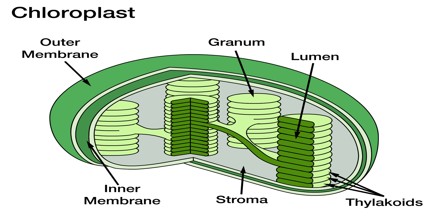CHLOROPLASTS:
Chloroplasts are membrane-bound plastids that
contain a network of membranes embedded in the liquid. These are the organelles
that conduct photosynthesis with the help of pigment called as "Chlorophyll".
It is this pigment that imparts a green color to the leaves and other parts of
the plants and captures light energy from the sunlight. Chloroplasts are
important because if there were no chloroplasts, plants cannot produce energy
in the daylight and the whole survival of living organisms become difficult.
These are present only in plant cells and are absent in animal cells. These
chloroplasts are also found in bacteria, blue-green algae, etc. These are the
sites of photosynthesis.
The word chloroplast is derived from the Greek words 'chloros'
meaning "green" and 'plastes 'meaning "formed".
Chloroplasts were first discovered in the early 17th century, by "Antony
Van Leeuwenhoek" and "Nehemiah Grew". These
chloroplasts can be found in the mesophyll cells of plants where are they
usually 30-40 per mesophyll cells. Chloroplasts are a type of plastids, some
other types are leucoplasts, chromoplasts, etc.

Chloroplasts are the part of the plant and algal cells that carry out
photosynthesis, the process of converting light energy into energy stored in
the form of sugar and other organic molecules. The process of photosynthesis
has two stages. In the first stage, light-dependent reactions occur which
captures sunlight through chlorophyll to form Adenosine triphosphate (ATP),
Nicotinamide adenine dinucleotide phosphate (NADPH). In the second stage, light-independent
reactions occur (also known as Calvin cycle), where the electrons carried by
NADPH convert inorganic carbon dioxide to an organic compound called as
carbohydrate. This is known as CO2 fixation. Carbohydrates and other organic molecules
can be stored and used for energy.
Structure of chloroplast:
Chloroplasts are oval-shaped and
consist of two membranes, ie, the outer membrane that forms the external
surface of it and an inner membrane that lies just beneath it. An intermembrane
is present between the outer and inner membrane. The space within the inner
membrane is called "stroma". It also contains many
small disc-shaped sacs called "thylakoids" that are
stacked upon one another. The main components of the chloroplast are:
1.
Envelope:
a) Outer
membrane: The entire chloroplast is bounded by an outer double unit membrane. It is a semi-porous membrane that is permeable to
small molecules and ions that diffuse easily. It is not permeable to large
molecules or proteins.
b) Inner
membrane: It is
present just beneath the outer membrane and forms a boundary to the stroma.
Fatty acids, lipids, carotenoids, etc, are synthesized in this membrane. It also
regulates the passage of materials in and out of the membrane.
c) Intermembrane
space: The space between
the inner and outer membrane is called intermembrane space. It is usually
thin and about 10-20 nanometres.

2. Stroma:
- Stroma is an alkaline, aqueous fluid that is present in
the inner membrane of the chloroplast.
- It is protein-rich and contains about 50% of the
proteins of the chloroplast.
- Stroma also contains chromosomes and DNA molecules.
- It is the place where carbon dioxide fixation takes place and the synthesis of sugar, starch, and other proteins takes place.
- It is a gel-like fluid that surrounds the thylakoids.
- A disc of flattened membranous sacs is called as
Thylakoids and a collection of these are called a Thylakoid system.
- Chlorophyll is found in the thylakoids and is the site of light reaction and photosynthesis processes.
- These thylakoids are arranged in stacks called "grana".
Each granum consists of 10-30 thylakoids.
- The number of thylakoids per granum varies from 1-50 or more. For eg; there may be a single thylakoid in red algae, paired algae in chrysophytes and triple and multiple in green algae and higher plants.
- Structural lipids of thylakoids are present here that include glycolipids, sulpholipids, and a few phospholipids, etc.
- These structural lipids are highly unsaturated which counter a high degree of humidity to the membrane of thylakoids.
- The protein components of thylakoids involve in the following complexes such as Photosystem-I, Photosystem-II, Cytochrome, ATP synthesis, Light-harvesting compound.

Functions
of Chloroplasts:
- Chloroplasts are the site of photosynthesis that comprises
of light-dependent and light-independent reactions to convert solar energy
into usable and stored energy.
- These involve in the regulatory functions and helps in
the synthesis of proteins and lipids.
- Production of ATP and NADPH by phosphorylation.
- Light reactions take place in membranes of thylakoids
- Dark reactions take place in the stroma.
- Conversion of PGA into sugars and starch that can be
stored.
- Courtesy by google images
No comments:
Post a Comment